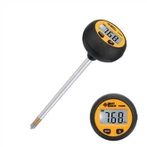Optical microscope structural components and function description
1. Mechanical part:
The mechanical part of the microscope includes the lens base, lens barrel, objective converter, stage, pusher, coarse adjustment handwheel, fine adjustment handwheel and other components.
1) Mirror base: The mirror base is the basic bracket of the microscope. It consists of two parts: the base and the mirror arm. There is a stage and lens tube attached to it, which is the basis for installing the components of the optical magnification system. The base and mirror arms stabilize and support the entire microscope.
2) Lens tube: The eyepiece is connected to the upper part of the lens tube and the converter is connected to the lower part, forming a dark room between the eyepiece and the objective lens (installed under the converter). The distance from the rear edge of the objective lens to the rear end of the lens tube is called the mechanical tube length. Because the magnification of the objective lens is based on a certain length of the lens barrel. Changes in the length of the lens barrel not only change the magnification, but also affect the image quality. Therefore, when using a microscope, the length of the lens barrel cannot be changed arbitrarily. The international standard barrel length of a microscope is 160mm, and this number is usually marked on the outer shell of the objective lens. There are two types of lens tubes: single-tube lens and binocular lens. Single-tube lens tubes are divided into upright and tilted types, while binocular lens tubes are all tilted.
3) Objective lens converter: Three to four objective lenses can be installed on the objective lens converter, usually three objective lenses (low magnification, high magnification and oil lens). By turning the converter, you can align one of the objective lenses with the lens barrel as needed (note that you are turning the converter to change the lens, you cannot hold the objective lens to turn it), and form a magnifying system with the eyepiece.
4) Stage: There is a hole in the center of the stage, which is a light channel. There are spring specimen clamps and pushers installed on the stage, which are used to fix and move the position of the specimen so that the microscope object is exactly in the center of the field of view.
5) Pusher: It is a mechanical device for moving specimens. It is composed of a metal frame with two pushing gear shafts, one horizontal and one vertical. A good microscope has scales engraved on the vertical and horizontal frame rods to form a very precise plane coordinate. Tie. If we need to observe a certain part repeatedly, we can write down the values of the vertical and horizontal rulers and then move to the same value to find it.
6) Coarse adjustment handwheel (coarse spiral): The coarse adjustment handwheel is a device that quickly moves to adjust the distance between the objective lens and the specimen.
7) Fine adjustment handwheel (fine spiral): The coarse adjustment handwheel can only roughly adjust the focus. To get the clearest object image, you need to use the macro spiral for fine adjustment.
2. Lighting part
Installed below the stage, it consists of a reflector (or light source), condenser and aperture.
1) Reflector: Early optical microscopes used natural light to examine objects, and a reflector was installed on the mirror base. A reflector is composed of a flat surface and another concave mirror, which can reflect the light projected on it to the condenser lens to illuminate the specimen. Concave mirrors are also used to focus light. Modern optical microscopes generally use electric light sources without reflectors and can adjust the light intensity.
2) Concentrator: The condenser is under the stage. It consists of a set of condenser lenses and a lifting screw. The condenser is installed under the stage, and its function is to focus the light reflected by the light source on the sample to obtain the strongest illumination, so that the object image can be bright and clear. The height of the condenser can be adjusted so that the focus falls on the object being inspected to obtain maximum brightness. Generally, the focus of the condenser is 1.25mm above it, and its lifting limit is 0.1mm below the stage plane. Therefore, it is required that the thickness of the slide should be between 0.8 and 1.2 mm, otherwise the sample to be inspected will not be in focus and the effect of microscopic examination will be affected.
3) Aperture: There is also an iridescent aperture in front of the front lens group of the condenser. It can be opened and closed to control the amount of light passing through, thus affecting the resolution and contrast of imaging. If the iridescent aperture is opened too large, it will exceed the value of the objective lens. When the aperture is too small, light spots will occur; if the iridescent aperture is too small, the resolution will decrease and the contrast will increase. Therefore, when observing, adjust the iridescent aperture and then open the field diaphragm (microscope with field diaphragm) to the outside of the periphery of the field of view, so that no light is illuminated outside the field of view to avoid scattering light interference.
3. Optical part
1) Eyepiece: Installed on the upper end of the lens tube, there are single-tube and binocular eyepieces, and 5×, 10×, 15× and 20× eyepieces are commonly used.
2) Objective lens: The object lens installed on the converter makes the object under inspection form a primary image. The quality of the objective lens imaging has a decisive impact on the resolution. There are generally 3-4 objective lenses (as shown in Figure 3). The main performance indicators are usually marked on the objective lens, namely magnification and lens opening ratio, such as 10/0.25, 40/0.65 and 100/1.30.






